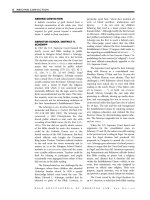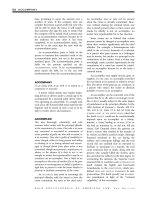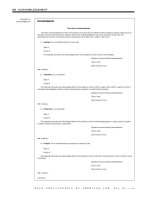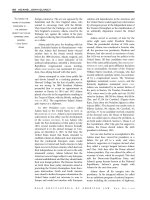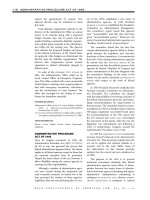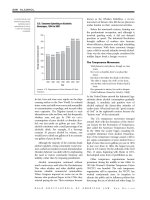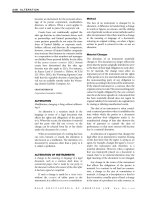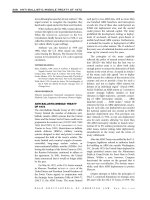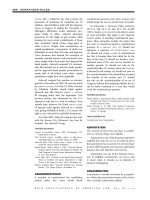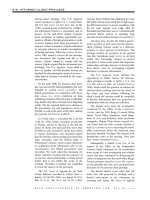Gale Encyclopedia Of American Law 3Rd Edition Volume 6 P9 ppsx
Bạn đang xem bản rút gọn của tài liệu. Xem và tải ngay bản đầy đủ của tài liệu tại đây (182.9 KB, 10 trang )
Should Judges Have Absolute
or Qualified Immunity?
T
he U.S. Supreme Court has made
clear that when judges perform
judicial acts within their jurisdiction, they
are absolutely immune from money
damages lawsuits. When judges act out-
side their judicial function, such as in
supervising their employees, they do not
have absolute immunity. The Court’s
upholding of absolute immunity has
troubled some legal commentators, who
believe that in appropriate circumstances
judges should be held personally account-
able for judicial actions that are unlawful.
Defenders of absolute immunity
claim that it is required for the benefit
of the public, not for the protection of
MALICIOUS or corrupt judges. The legiti-
macy of U.S. courts rests on the public’s
belief that judges have the freedom to act
independently, without fear of the con-
sequences. Absolute immunity provides
the buffer needed for a judge to act.
In the adversarial process, one party
wins, and the other party loses. Losing
parties are inevitably disappointed, and
some seek ways of venting their frustra-
tion at the legal system. Some file
complaints with lawyer discipline boards,
alleging ethical misconduct by the oppos-
ing party’s attorney or their own attorney.
Some file complaints with a judicial
conduct board, claiming that the trial
judge violated a canon of judicial conduct.
Though these types of complaints do not
result in the relitigation of a lawsuit, they
do illustrate the
VEXATIOUS LITIGATION that
faces attorneys and judges. Allowing
parties to sue a judge for a judicial act
would invite a torrent of meritless suits
that would impede the judicial system.
Defenders of absolute immunity note
that a flood of litigation would not be the
only consequence of relaxing the immunity
standard. They saythat once judges became
liable for damages suits, self-interest would
lead them to avoid making decisions likely
to provoke such suits. The resulting over-
cautiousness and timidity might be hard
to detect, but it would impair independent
and impartial adjudication.
Judges do make honest mistakes
during the course of trial. The law is
complex, and judges cannot call a recess
of court to research every motion before
making a decision. If a judge could be
sued for damages, another judge might
have to rule that the
DEFENDANT judge was
liable for injuries due to an erroneous
decision or procedural flaw. Having
judges judge one another could erode
the integrity of the courts and undermine
public confidence.
Defenders of absolute immunity also
point out that appellate review is a viable
remedy for correcting judicial conduct.
In addition, if a judge has violated the
canons of judicial conduct, judicial
conduct boards may issue sanctions,
including a recommendation of removal
from the bench. A judge can be prose-
cuted for criminal acts. In some states
judges may be impeached, and most state
court judges must stand for election
periodically. All these options serve as
checks on judicial behavior and provide
protection to the public.
Those who criticize absolute immu-
nity recognize that judicial independence
must be preserved. Nevertheless, they
claim that in certain situations the only
way to protect the public is to allow
personal lawsuits against judges. By
totally insulating judges from personal
responsibility for their actions, the judi-
cial system allows a small number of
judges to escape the consequences of
unlawful and outrageous behavior. The
public loses respect when it sees a judge
“beat the system,” while the victim loses
the chance to be made whole for the
injuries flowing from the judicial act.
These critics believe that a qualified
immunity standard would protect judges
from meritless lawsuits and guarantee
victims of unlawful judicial conduct their
opportunity to seek damages. Qualified
immunity is a lesser form of immunity
that may be granted by a court if the
judge demonstrates that the law was not
clear on the subject in which the judge’s
actions occurred. They point out that the
executive branch is governed by qualified
immunity. There is no indication that
the administration of government has
ground to a halt, or that the executive
branch cannot attract high-quality indi-
viduals to government service. A well-
articulated qualified immunity standard
would allow a lawsuit against a judge to
be dismissed if it could be established
that the judge was operating within
accepted judicial authority.
The critics note that the alternative
remedies offered by the defenders of
absolute immunity do not address the
type of conduct that would be the focus
of a
PERSONAL INJURY lawsuit against a
judge. For example, in Stump v. Spark-
man, 435 U.S. 349, 98 S. Ct. 1099, 55 L.
Ed. 2d 331 (1978), the judge issued an
order to sterilize a teenage girl without
the order ’s ever having been filed with
the clerk of court. Because there was no
record of a case filing or decision, the
order could not be reviewed by an
appellate court. The judge could be
sanctioned by the judicial conduct board,
but that would not compensate the
victim of the illegal sterilization. Absolute
immunity allowed the court to dismiss
the girl’s claim because the “ judicial act”
was one normally performed by a judge
and was within the judge’s judicial
capacity.
Supporters of qualified immunity
discount the assumption that it would
precipitate a flood of litigation. They
maintain that decisions that judges typi-
cally make will seldom be litigated, as
appellate review will satisfy most litigants.
However,intherarecircumstances
whereajudgeabusesherauthorityand
someone is injured, these supporters
contend, it is only fair to qualify a judge’s
personal immunity. They argue that the
removal of absolute immunity would,
over time, deter judi cial abuse: Judg es
would not be intimidated, but they would
be more careful to safeguard the rights of
all parties.
GALE ENCYCLOPEDIA OF AMERICAN LAW, 3RD E DITION
68 JUDICIAL IMMUNITY
result of the order. At trial, Bradley attempted to
introduce evidence in his favor, but Fisher ’s
attorney objected to each item, and the judge
excluded each item. After three failed attempts
to present evidence, the trial court directed the
jury to deliver a verdict in favor of Fisher.
On appeal by Bradley, the U.S. Supreme
Court affirmed the trial court’s decision. Judges
could be reached for their
MALICIOUS acts, but only
through
IMPEACHMENT, or removal from office.
Thus, the facts of the case were irrelevant. Even if
Fisher had exceeded his jurisdiction in single-
handedly banning Bradley from the court, Fisher
was justified in his actions. According to the
Court, “A judge who should pass over in silence
an offence of such gravity would soon find
himself a subject of pity rather than respect.”
Since Bradley, the U.S. Supreme Court has
identified some exceptions to judicial immunity.
Judges do not receive imm unity for their
administrative decisions, such as in hiring and
firing court employees (Forrester v. White, 484
U.S. 219, 108 S. Ct. 538, 98 L. Ed. 2d 555 [1988]).
Judges also are not immune from declaratory
and injunctive relief. These forms of relief differ
from monetary relief. Generally they require
parties to do or refrain from doing a certain
thing. If a judge loses a suit for
DECLARATORY
JUDGMENT
or injunct ive relief, he or she may not
be forced to pay money damages, but may be
forced to pay the court costs and attorneys’ fees
of the winning party. For example, assume that a
judge requires the posting of bail by persons
charged in criminal court with offenses for which
they cannot be jailed. If a person subjected to
this unconstitutional practice files suit against
the judge, the judge will not be given judicial
immunity and, upon losing the case, will be
forced to pay the plaintiff’s attorney’s fees and
court costs. (Pulliam v. Allen, 466 U.S. 522, 104
S. Ct. 1970, 80 L. Ed. 2d 565 [1984]).
The Court held in Pulliam that a judge
could be forced to pay the plaintiff’s attorney’s
fees and court costs under the 1976
CIVIL RIGHTS
Stump v. Sparkman
T
B
he U.S. Supreme Court has consistently upheld
absolute immunity for judges performing judi-
cial acts, even when those acts violate clearly
established judicial procedures. In Stump v.
Sparkman, 435 U.S. 349, 98 S. Ct. 1099, 55 L. Ed. 2d
331 (1978), the Court held that an Indi ana state
judge, who ordered the sterilization of a female
minor without observing due process, could not be
sued for damages under the federa l civil rights
statute (42 U.S.C.A. § 1983).
In 1971 Judge Harold D. Sparkman, of the Circuit
Court of DeKalb County, Indiana, acted on a petition
filed by Ora McFarlin, the mother of 15-year-old
Linda Spitler. McFarlin sought to have her daughter
sterilized on the ground s he was a “somewhat
retarded” minor who had been staying out overnight
with older men.
Judge Sparkman approved and signed the
petition, but the petition had not been filed with
the court clerk and the judge had not opened a
formal case file. The judge failed to appoint a
guardian ad litem for Spitler, and he did not hold
a hearing on the matter before authorizing a tubal
ligation. Spitler, who did not know what the
operation was for, discovered she had been
sterilized only after she was married. Spitl er, whose
married name w as Stump, then sued Sparkman.
The Supreme Court ruled that Sparkman was
absolutely immune because what he did was “a
function normally pe rformed by a judge,” and he
performed the act in his “ judici al capacity.”
Although he may have violated state laws and
procedures, he performed judicial functions that
have historically been absolutely immune to civil
lawsuits.
In a dissenting opinion, Justice Potter Stewart
argued that Sparkman’s actions were not absolutely
immune simply because he sat in a courtroom, wore
a robe, and signed an unlawful order. In Stewart’s
view the conduct of a judge “surely does not
become a judicial act merely on his say so. A judge
is not free, like a loose cannon, to inflict in discrimi-
nate damage whenever he announces that he is
acting in his judicial capacity.”
GALE ENCYCLOPEDIA OF AMERICAN LAW, 3RD E DITION
JUDICIAL IMMUNITY 69
Attorney’s Fees Awards Act, 42 U.S.C.A. § 1988.
Gladys Pulliam, a Virginia state court magis-
trate, had jailed two men for failure to post bail
following their arrest for abusive language and
public drunkenness. Under Virginia law, the
defendants could not receive a jail sentence if
convicted of these offenses. The plaintiffs sued
under the federal civil rights act 42 U.S.C.A.
§ 1983 and obtained an injunction forbidding
the judge to require bail for these offenses. The
judge was also ordered to pay the defendants
$8,000 as reimbursement for their attorneys’ fees.
Judges throughout the United States viewed
the Pulliam decision as a serious
ASSAULT on
judicial immunity. The Conference of State Chief
Justices, the
JUDICIAL CONFERENCE OF THE UNITED
STATES
,theAMERICAN BAR ASSOCIATION,andthe
American Judges Association lobbied Congress
to amend the law and overturn Pulliam.Finally,
in the Federal Courts Improvement Act of 1996
(Pub. L. No. 104-317, 110 Stat. 3847), Congress
inserted language that voided the decision. The
amendment prohibits injunctive relief in a §
1983 action against a “judicial officer for an act
or omission taken in such officer’sjudicial
capacity” unless “a declaratory decree was
violated or declaratory relief was unavailable.”
In addition, language was added to § 1988 that
precludes the award of costs and attorney’sfees
against judges acting in their official capacity.
Filing a civil
COMPLAINT against a judge can be
risky for attorneys because the doctrine of judicial
immunity is well established. In Marley v. Wright,
137 F.R.D. 359 (W.D. Okla. 1991), attorney Frank
E. Marley sued two Oklahoma state court judges,
Thornton Wright, Jr., and David M. Harbour,
their
COURT REPORTER, and others. Marley alleged
in his complaint that Wright and Harbour had
violated his constitutional rights in connection
with a custody case concerning Marley’schildren.
The court not only dismissed the case, but also
ordered Marley to pay the attorney’sfeesthat
Wright and Harbour had incurred in defending
the suit. According to the court, Marley’s
complaint “was not warranted by existing law,”
and Marley had used the suit “not to define the
outer boundaries of judicial immunity but to
harass judges and judicial personnel who
rendered a decision he did not like.”
FURTHER READINGS
Block, Frederic. 1999. “Qualified Immunity: A View from
the Bench.” Touro Law Review 15 (summer).
Duffy, Shannon P. 1999. “Judges Have Absolute Immunity
for Actions on the Bench, Circuit Rules.” New Jersey
Law Journal 157 (September 27).
Morgan, Thomas D., and Ronald D. Rotunda. 2008. Morgan
and Rotunda’s Professional Responsibility, Problems and
Materials. 10th ed. St. Paul, MN: Foundation.
Romo, Cheryl. 2002. “Jurist’s Infamous Case Set Judicial
Immunity Precedent.” The Los Angeles Daily Journal
115 (December 30).
JUDICIAL NOTICE
A doctrine of evidence applied by a court that
allows the court to recognize and accept the
existence of a particular fact commonly known by
persons of average intelligence without establishing
its existence by admitting evidence in a civil or
criminal action.
When a court takes judicial notice of a
certain fact, it obviates the need for parties to
prove the fact in court. Ordinarily, facts that
relate to a case must be presented to the judge
or jury through testimony or tangible evidence.
However, if each fact in a case had to be proved
through such presentation, the simplest case
would take weeks to complete. To avoid
burdening the judicial system, all legislature s
have approved court rules that allow a court to
recognize facts that constitute common knowl-
edge without requiring proof from the parties.
On the federal trial court level, judicial
notice is recognized in rule 201 of the
FEDERAL
RULES OF EVIDENCE
for U.S. District Courts and
Magistrates. Rule 201 provides, in part, that “[a]
judicially noticed fact must be one not subject
to reasonable dispute in that it is either
(1) generally known within the territorial jurisdic-
tion of the trial court or (2) capable of accurate
and ready determinat ion b y resort t o s ources
whose accuracy cannot r easonably be q uestioned.”
Under rule 201 a trial court must take
judicial notice of a well-known fact at the request
of one of the parties, if the court is provided
with information supporting the fact. A court
also has the option to take judicial notice at its
discretion, without a request from a party.
Rule 201 further provides that a court
may take judicial notice at any time during a
proceeding. If a party objects to the taking of
judicial notice, the court must give that party an
opportunity to be heard on the issue. In a civil
jury trial, the court must inform the jury that it
must accept the judicially noticed facts in the
case as conclusively proved. In a criminal trial
by jury, the court must instruct the jury “that it
GALE ENCYCLOPEDIA OF AMERICAN LAW, 3RD E DITION
70 JUDICIAL NOTICE
may, but is not required to, accept as conclusive
any fact judicially noticed.” All states have
statutes that are virtually identical to rule 201.
The most common judicially noticed facts
include the location of streets, buildings, and
geographic areas; periods of time; business
customs; historical events; and federal, state,
and
INTERNATIONAL LAW. Legislatures also main-
tain statutes that give courts the power to
recognize certa in facts in specific situations. For
example, in Idaho any document affixed with
the official seal of the state public utilities com-
mission must be judicially noticed by all courts
(Idaho Code § 61-209 [1996]). In Hawaii, when a
commercial vehicle is cited for violating vehicle
equipment regulations, a trial court must take
judicial notice of the driver’s subordinate position
if the driver works for a company that owns
the vehicle (Haw. Rev. Stat. § 291-37 [1995]).
The danger of judicial notice is that, if
abused, it can deprive the fact finder of the
opportunity to decide a contestable fact in a case.
In Walker v. Halliburton Services,654So.2d365
(La. App. 1995), Johnny Walker fell from a tank
truck approximately ten feet to a concrete floor.
Walker sought workers’ compensation benefits
for his injuries, and his claim was denied by
theOfficeofWorkers’ Compensation.
At the application hearing, the hearing
officer stated that it was her experience that a
soft-tissue injury heals in six weeks. She then
took judicial notice of the fact that a soft-tissue
injury heals in six weeks—preventing Walker
from contesting that proposition—and disal-
lowed Walker’s claim. On appeal the Louisiana
COURT OF APPEAL, Third Circuit, reversed the
decision and ordered the paymen t of workers’
compensation benefits. According to the court,
it was a clear error of law for the hearing officer
to take judicial notice of such intricate medical
knowledge.
JUDICIAL REVIEW
A court’s authority to examine an executive or
legislative act and to invalidate that act if it is
contrary to constitutio nal principles.
The power of courts of law to review the
actions of the executive and legislative branches
is called judicial review. Though judicial review
is usually associated with the U.S. Supreme
Court, which has ultimate judicial authority, it
is a power possessed by most federal and state
courts of law in the United States. The concept
is an American invention. Prior to the early
1800s, no country in the world gave its judicial
branch such authority.
In the UnitedStates, the supremacyof national
law is established by Article VI, Clause 2,
of the U.S. Constitution. Called the
SUPREMACY
CLAUSE
, it states that “This Constitution, and
the laws of the United States which shall be
made in pursuance thereof … shall be the
supreme law of the land.” It goes on to say that,
“judges in every state shall be bound thereby.”
This means that state laws may not violate the
U.S. constitution and that all state courts must
uphold the national law . State courts uphold
the national law through judicial review.
Through judicial review, state courts deter-
mine whether or not state executive acts or state
statutes are valid. They base such rulings on the
principle that a state law that violates the U.S.
constitution is invalid. They also decide the
constitutionality of state laws under state con-
stitutions. If, however, state constitutions con-
tradict the U.S. Constitution, or any other
national statute, the state constitution must
yield. The highest state court to decide such
issues is the state supreme court.
While judicial review of state laws is clearly
outlined in the supremacy clause, the Framers
of the U.S. Constitution did not resolve the
question of whether the federal courts should
have this power over congressional and execu-
tive acts. During the early years of the Republic,
the Supreme Court upheld congressional acts,
which implied the power of judicial review. But
the key question was whether the Court had
the power to strike down an act of Congress.
In 1803 the issue was settled in
MARBURY V.
MADISON, 5 U.S. (1 Cranch) 137, 2 L. Ed. 60,
when the Supreme Court, for the first time,
ruled an act of Congress unconstitutional. In
Marbury, Chief Justice
JOHN MARSHALL reasoned
that since it is the duty of a court in a lawsuit
to declare the law, and since the Constitution is
the supreme
LAW OF THE LAND, where a rule of
statutory law conflicts with a rule of the
Constitution, then the law of the Constitution
must prevail. Marshall asserted that it is
“emphatically the province and duty of the
judicial department, to say what the law is.”
Having established the power of judicial
review, the Supreme Court applied it only
once prior to the Civil War, in 1857, ruling the
GALE ENCYCLOPEDIA OF AMERICAN LAW, 3RD E DITION
JUDICIAL REVIEW 71
MISSOURI COMPROMISE OF 1820 unconstitutional in
DRED SCOTT V. SANDFORD, 60 U.S. (19 How.) 393,
15 L. Ed. 691. During the same period, the
Court invalidated several state laws that came in
conflict with the Constitution. In M’Culloch v.
Maryland, 17 U.S. 316, 4 L. Ed. 579 (1819), the
Court invalidated a state’s attempt to tax a
branch of the
BANK OF THE UNITED STATES.In
GIBBONS V. OGDEN, 22 U.S. 1, 6 L. Ed. 23 (1824),
the Court struck down a New York law granting
a monopoly to a steamboat company, saying
that the state law conflicted with a federal law
granting a license to another company.
In addition to invalidating state laws, the
Marshall Court established the authority to
overrule decisions of the highest state courts. In
Martin v. Hunter’s Lessee, 14 U.S. 304, 4 L. Ed.
97 (1816), the Court referred to the supremacy
clause to assert that its appellate power extended
to state courts.
Following the Civil War, the Supreme Court
grew concerned that the recently-passed
FOUR-
TEENTH AMENDMENT
would give the federal
government too much power over state govern-
ments and individual rights. Therefore, it used
the power of judicial review to strike down
federal
CIVIL RIGHTS laws that sought to address
racial discrimination in the former Confederate
states. Beginning in 1890, the Court became
embroiled in political controversy when it
exercised its power of judicial review to limit
government regulation of business. In Chicago,
Milwaukee, & St. Paul Railroad Co. v. Minne-
sota, 134 U.S. 418, 10 S. Ct. 462, 33 L. Ed. 970
(1890), the Court struc k down a state law
establishing a commission to set railroad rates.
This case was the first of many where the Court
applied the doctrine of
SUBSTANTIVE DUE PROCESS
to invalidate state and federal legislation that
regulated business. Substantive due process was
a vague concept that required legislation to be
fair, reasonable, and just in its content.
Through the early 1900s, the Court came
under attack from Populists and Progressives
for its desire to insulate capitalism from govern-
ment intervention. Unmoved by its critics, the
Court proceeded to invalidate a federal income
tax (Pollock v. Farmers’ Loan & Trust Co., 157
U.S. 429, 15 S. Ct. 673, 39 L. Ed. 759 [1895]),
limit the scope of the
SHERMAN ANTI-TRUST ACT
(United States v. E. C. Knight Co., 156 U.S. 1, 15
S. Ct. 249, 39 L. Ed. 325 [1895]), and for-
bid states to regulate working hours (
LOCHNER V.
NEW YORK, 198 U.S. 45, 25 S. Ct. 539, 49 L. Ed.
937 [1905]).
The Supreme Court’s use of substantive due
process brought charges of “judicial activism,”
which means that in determining whether laws
would meet constitutional muster, the Court
was accu sed of acting more as a legislative body
than as a judicial body. Justice Oliver Wendell
Holmes Jr., in his famous dissenting opinion in
Lochner, argued for “judicial restraint,” caution-
ing the Court that it was usurping the function
of the legislature.
Despite Holmes’s warning the Court
continued to strike down laws dealing with
economic regulation into the 1930s. In 1932,
the United States, in the midst of the Great
Depression, elected
FRANKLIN D. ROOSEVELT presi-
dent. Roosevelt immediately began to imple-
ment his
NEW DEAL program, which was based
on the federal government’s aggressive regula-
tion of the national economy. The Supreme
Court used its power of judicial review to
invalidate eight major pieces of New Deal
legislation.
Roosevelt, angry at the conservative justices
for blocking his reforms, proposed legislation
that would add new appointees to the Court—
appointees that would create a liberal majority.
This “court-packing” plan aroused bipartisan
opposition and ultimately failed. But the Court
may have gotten Roosevelt’s message, for in
1937, it made an abrupt turnabout: a majority
of the Court abandoned the substantive due
process doctrine and voted to uphold the
WAGNER ACT, which guaranteed to industrial
workers the right to unionize and bargain
collectively (
NATIONAL LABOR RELATIONS BOARD V.
Jones & Laughlin Steel Corp., 301 U.S. 1, 57 S.
Ct. 615, 81 L. Ed. 893 [1937]).
With this decision the Court ceased to
interpret the Constitution as a barrier to social
and economic legislation. The Court subse-
quently upheld congressional legislation that
affected labor relations, agricultural production,
and social welfare. It also exercised judicial
restraint with respect to state laws regulating
economic activity.
Beginning in the 1950s, the Supreme Court
exercised its judicial review power in cases
involving civil rights and civil liberties. During
the tenure of Chief Justice
EARL WARREN, from
1953 to 1969, the Court declared federal statutes
unconstitutional in whole or in part in 25 cases,
GALE ENCYCLOPEDIA OF AMERICAN LAW, 3RD E DITION
72 JUDICIAL REVIEW
most of the decisions involving civil liberties.
The Warren Court’s decision in BROWN V. BOARD
OF EDUCATION
, 347 U.S. 483, 74 S. Ct. 686, 98 L.
Ed. 873 (1954), however, invalidated state laws
that mandated racially segregated public schools.
The Supreme Court became increasingly
conservative in the 1970s. Yet, in 1973, under
Chief Justice
WARREN E. BURGER, it invalidated
state laws prohibiting
ABORTION in ROE V. WADE,
410 U.S. 113, 93 S. Ct. 705, 35 L. Ed. 2d 147.
Since the elevation of
WILLIAM H. REHNQUIST to
chief justice in 1986, the Court has continued
its movement to the right, although it has not
retreated from most of the protections it
recognized under Warren in the realm of civil
rights and civil liberties.
The exercise of judicial review is subject to
important rules of judicial self-restraint, which
restrict the Supreme Court, and state courts as
well, from extending its power. The Supreme
Court will hear only cases or controversies,
actual live disputes between adversary parties
who are asserting valuable legal rights. This
means the Court cannot issue advisory opinions
on legislation. In addition, a party bringing suit
must have standing (a direct stake in the
outcome) in order to challenge a statute.
The most important rule of judicial restraint
is that statutes are presumptively valid, which
means that judges assume legislators did not
intend to violate the Constitution. It follows
that the
BURDEN OF PROOF is on the party that
raises the issue of unconstitutionality. In addi-
tion, if a court can construe a disputed statut e in
a manner that allows it to remain intact without
tampering with the meaning of the words or if a
court can decide a case on nonconstitutional
grounds, these courses are to be preferred.
Finally, a court will not sit in judgment of the
motives or wisdom of legislators, nor will it hold
a statute invalid merely because it is deemed to
be unwise or undemocratic.
FURTHER READINGS
Curtis, Kent. 2003. “Judicial Review and Populism.” Wake
Forest Law Review 38 (summer).
Dellinger, Walter, and Christopher H. Schroeder. 2003.
“The Case for Judicial Review.” Washington Post
(December 6).
Kramer, Larry D. 2004. The People Themselves: Popular
Constitutionalism and Judicial Review. New York: Oxford
Univ. Press.
Lipkin, Robert Justin. 2000. Constitutional Revolutions:
Pragmatism and the Role of Judicial Review in American
Constitutionalism. Durham, NC: Duke Univ. Press.
Prakash, Saikrishna B., and John C. Yoo. 2003. “The Origins
of Judicial Review.” Univ. of Chicago Law Review 70
(summer). Available online at />sol3/papers.cfm?abstract_id=426860; website home
page: (accessed August 3, 2009).
Seidman, Louis Michael. 2001. Our Unsettled Constitution: A
New Defense of Constitutionalism and Judicial Review.
New Haven, CT: Yale Univ. Press.
CROSS REFERENCES
Due Process of Law; Separation of Powers; Supreme Court
of the United States.
JUDICIAL SALE
The transfer of title to and possession of a debtor’s
property to another in exchange for a price
determined in proceedings that are conducted under
a judgment or an order of court by an officer
duly appointed and commissioned to do so.
A judicial sale is a method plaintiffs use to
enforce a judgment. When a
PLAINTIFF wins a
judgment against a
DEFENDANT in civil court, and
the defendant does not pay the judgment, the
plaintiff can force the sale of the defendant’s
property until the judgment is satisfied. The
plaintiff forces the sale by filing in court for an
execution on property, which is a seizure of
property by the court for the purpose of selling
the property.
Judicial sales are regulated by state and
federal statute. In Alabama, for example, the
judicial sale process begins w hen a judgment
remains unpaid ninety days after it is placed on
the record by the court (Ala. Code § 6-9-21
[1995]). The plaintiff must bring an order
mandating payment of the judgment and court
costs to the county where the defendant’s
property is located. This order is called a writ
of execution, and it is issued by the trial court.
A writ of execution identifies the amount of
the judgment, interest, and court costs that the
defendant owes the plaintiff.
Generally, a writ of execution may be levied
against any real property or
PERSONAL PROPERTY of
the defendant. The plaintiff must file the writ of
execution with the probate judge in the county
where the defendant’s property is located. The
plaintiff must also give notice of the execution
on the defendant’s property to the defendant.
Once the writ is filed, the plaintiff has a
LIEN
on the defendant’s property. A lien gives the
plaintiff a legally recognized ownership interest
in the defendant’s property, equal to the amount
of the judgment.
GALE ENCYCLOPEDIA OF AMERICAN LAW, 3RD E DITION
JUDICIAL SALE 73
Once the plaintiff has obtained a lien on the
defendant’s property, the judicial sale can begin.
The process typically must be carried out within
a fixed time period, such as within ninety days
after the writ of execution is issued. The sheriff’s
office in the county where the property i s
located is responsible for levying, or seizing,
the property and for conducting the sale of the
property.
The sale of real prop erty may take place at
the courthouse. If the prop erty that the plaintiff
seeks is perishable and in danger of waste or
decay, the sale may occur at some other time
and place.
A defendant can avoid a judicial sale after a
writ of execution is issued, by paying the
judgment, interest, and court costs in full. If
the defendant appeals the judgment to a higher
court, the defendant may postpone the judicial
sale by posting a bond to secure the debt during
the appea ls process. If the defendant does not
plan to appeal, and the levying officer is about
to seize personal property, the defendant may
be able to keep the property until the day of sale
if the defendant gives the levying officer a bond
made payable to the plaintiff for a certain
amount, such as twice the amount in the writ of
execution.
Generally, judicial sales are the last resort
for a plaintiff trying to collect on a judgment.
A d efendant who owns or possesses valuable
property is usually able to satisfy a judgment
in civil court by leveraging the property, or
using it to borrow money to pay the judgment.
JUDICIAL WRITS
Orders issued by a judge in the English courts
after a lawsuit had begun.
An
ORIGINAL WRIT, issued out of the Chan-
cery, was the proper document for starting a
lawsuit in England for hundreds of years, but
courts could issue judicial writs during the
course of a proceeding or to give effect to their
orders after the lawsuit had commenced.
Unlike original writs, judicial writs were
issued under the private seal of the courts
rather than the king’s great seal, and they were
sent out in the name of the chief judge of
the court hearing the case rather than in the
king’s name. The capias was one form of a
judicial writ.
JUDICIARY
The judiciary is the branch of government that is
endowed with the authority to interpret and apply
the law, adjudicate legal disputes, and otherwise
administer justice.
The U.S. judiciary comprises a system of
state and federal courts, tribunals, and adminis-
trative bodies, as well as the judges and other
judicial officials who preside over them.
Every society in human history has con-
fronted the question of how to resolve disputes
among its members. Many early societies chose
a private system of revenge for dispute resolu-
tion. As civilization gradually evolved, commu-
nities began designating individuals to resolve
disputes in accordance with established norms
and customs. These individuals were usually
leaders who were expected to exercise their
judgment in an impartial manner.
The origins of
JUDICIAL ACTION, judicial
power, and judicial process may be traced to
the first communities that relied on neutral
third parties to resolve legal disputes. Judicial
action is any action taken by a court or other
judicial body to interpret, apply, or declare what
the law is on a particular issue during a legal
proceeding. It is also the action taken by a
judicial body to settle a legal dispute by issuing
an opinion, order, decree, or judgment. Judicial
power is the authority of a court to hear a
particular lawsuit or legal dispute and take
judicial action with regard to it. Judicial process
is the procedures by which a court takes judi cial
action or exercises its judicial power.
Ancient Greece, an early society in Western
civilization, evolving from about the sixth
century to the second century b.c., employed a
combination of judicial procedures. Greek
rulers, known as arkhons, w ere empowered to
hear a variety of disputes, as was the agora,a
group of respected elders in the community.
A court known as the Areopagus heard
MURDER
cases, but direct retaliation by private citizens
was still permitted in many civil disputes. The
judicial powers of these institutions were
gradually replaced by the Ekklesia, an assembly
of six thousand jurors that was divided into
smaller panels to hear particular cases.
Juries played an integral role in the
development of the English judicial system. As
more legal disputes were submitted to juries for
resolution, this system became more self-
conscious. Concerns were expressed that both
GALE ENCYCLOPEDIA OF AMERICAN LAW, 3RD E DITION
74 JUDICIAL WRITS
judges and juries were rendering biased deci-
sions based on irrelevant and untrustworthy
evidence. Litigants complained that trial proce-
dures were haphazard, arbitrary, and unfair.
Losing parties sought effective remedies to
redress erroneous decisions made at the trial
court level. Each of these concerns has mani-
fested itself in the modern judicial system of the
United States.
The blueprints for the U.S. judiciary were
laid out in 1789. During that year the U.S.
Constitution was formally adopted by the states.
Article III of the Constitution delineates the
general structure of the federal judicial system,
including the powers and obligations of federal
courts. The
JUDICIARY ACT OF 1789 (1 Stat. 73
[codified as amended in 28 U.S.C.A.]) explains
many details of federal judicial power that were
not addressed by the Constitution. The blue-
prints for the state judicial systems were created
similarly by state constitutional and statutory
provisions.
The U.S. judicial system has three principal
characteristics: It is part of a federalist system of
government, it has a specific role under the
federal separation-of-power s doctrine, and it is
organized in a hierarchical fashion.
Federalism
The judiciary is part of a federalist system in
which the state and federal governments share
authority over legal matters arising within their
geographic boundaries. In some instances, both
state and federal courts have the power to hear
a legal dispute that arises from a single set of
circumstances. For example, four Los Angeles
police officers who were accused of participat-
ing in the 1991 beating of speeding motorist
RODNEY G. KING faced prosecution for excessive
use of force in both state and federal court.
In other instances, a state or federal court has
exclusive jurisdiction over a particular legal
matter. For example, state courts typically have
exclusive jurisdiction over matrimonial law, and
federal courts have exclusive jurisdiction over
BANKRUPTCY law.
Separation of Powers
Under the separation-of-powers doctrine, the
judiciary shares power with the executive and
legislative branches of government at both the
state and federal levels. The judiciary is delegat-
ed the duty of interpreting and applying the
laws that are passed by the legislature and
enforced by the executive branch.
Article I of the U.S. Constitution grants
Congress its lawmaking power, and Artic le II
authorizes the president to sign and veto legis-
lation and to execute laws that are enacted.
Article III grants the federal judiciary t he power
to adjudicate lawsuits that arise under the
Constitution, congressional law, and treaties
with foreign countries.
Hierarchy of U.S. Appellate Judiciary
Supreme Court
Courts of Appeal
(11 numbered circuits
plus District of
Columbia Circuit)
Court of Appeals
for the Federal
Circuit
Court of Appeals
for the
Armed Forces
Ninety-four U.S.
District Courts
Tax Court
Court of
International Trade
Claims Court
Court of Veterans
Appeals
Army, Navy-Marine
Corps, Coast Guard,
and Air Force Courts
of Criminal Appeals
ILLUSTRATION BY GGS
CREATIVE RESOURCES.
REPRODUCED BY
PERMISSION OF GALE,
A PART OF CENGAGE
LEARNING.
GALE ENCYCLOPEDIA OF AMERICAN LAW, 3
RD E DITION
JUDICIARY 75
The Politicizing of American
Jurisprudence
A
B
n old saying goes, “A judge is a lawyer who
knew a governor (or senator or president).”
The inference is unavoidable: Judges are pol itical
creatures. From ma ny of the nation’s l aw professors
to leading members of its foremost bar association,
some legal experts think this assertion is regrettably
all too true.
Only federal judges and a handful of state
judges are appointed for life, barring impeachment.
In all other states and in local governments, most
judges a re elected by popular vote for a specific
term. Voters tend to elect persons who share their
views. The same is true for most gubernatorial
appointments, although in many states this tendency
is tempered by senatorial confirmation. Inescapably,
the development of platforms that represent the most
popular, prevailing, or promising views is a political
process.
In the words of John Adams’s Massachusetts
constitution, it has always been the desire to make
judges “as free, impartial and independent as the
lot of huma nity will ad mit.” In a political system in
which party politics are defined by social issues and
in which jurisprudence affects those issues. How-
ever, party alignment of judges seems inevitable,
either by default or by declaration. The extent is
arguable, but few would deny that judges assume
the bench based on ho w others perceive they will
run the court: conservatively or liberally.
Ostensible checks and balances exist, of
course. All judges are expected to follow ethical
standards requiring disinterested and unbiased
opinions, which most do. Most states have a code
of judicial conduct and/or ethics for t his purpose,
generally fashioned from that of the American Bar
Association (ABA). These codes proscribe many
instances of campaign conduct for prospective and
current judges. Judges ca nnot personally solicit or
accept campai gn funds and often are prohibited
from identifying themselves with any political party.
Typically, they must run on a non-partisan ticket.
But nothing prevents political action committees
(PACs) from making campaign contributions to
judges. Some scoff at the imposition of limits. “If
PACs are limited, people go out and create more
PACs,” explained Dick Wilcox, president of the
Business and Industry Politica l Education Commit-
tee in Mississippi. “If we althy individuals are
restricted, they give money to their secretaries,
wives, or children to contribute.” Contributions add
up: Michigan spent $16 million on judicial elections
in 2000 alone. In Georgia in 2002, races for two
Supreme Court seats garnered more than $700,000.
Electing judges, however, is unnecessary. As an
alternative, some point to the pioneering Missouri
system. Under this system, a governor appoints all
state trial and appellate judges with the advice and
consent of the legislature. Still another variation seeks
to further depoliticize such choices by requiring a
governor to select among nominees submitted by a
selection panel or special nominating committee.
Support for reform is growing. The American
Bar Association (ABA) has cal led for a sweeping
overhaul of the current state system. In 2003 the
ABA Commission on the 21st Century Judiciary
warned that partisanship over the courts was
escalating to crisis levels. Among 23 recommenda-
tions, the commission called for limiting judges to
service of either one long term or until a specific age,
without eligibility for retention or reelection. Such
limits are needed to “inoculate America’scourts
against the toxic effects of money, partisanship and
narrow interests,” the commission declared.
Advocates of r eform say it may cure other ills
and weaknesses, too. Reform might eliminate so-
called negative campaigning, which may create
perceptions among voters that justices are “bought”
by special interests. Moreover, judges may lose
independence out of fear that certain opinions will
be used against them in negative campaign ads.
Another blemish that might be cured is that of
real or perceived l awyer lobbying. For years,
attorneys—particularly plaintiffs’ lawyers— have
outspent the largest oil and automotive companies
in jud icial campaign contributions. The ABA has
spoken out sharply against attorneys contributing to
campaigns of judges before whom they do frequent
business or from whom they wish to gain court-
appointed business. Yet just like other campaign
contributors, attorneys are exercising their speech
GALE ENCYCLOPEDIA OF AMERICAN LAW, 3RD E DITION
76 JUDICIARY
Federal judges, including Supreme Court
justices, are not elected to office. Instead, they
are appointed to office by the
PRESIDENT OF THE
UNITED STATES
with the ADVICE AND CONSENT of the
Senate. Once appointed, federal judges hold
office for life, unless they resign or are impea-
ched for “Treason, Bribery, or other High Crimes
and Misdemeanors” (U.S. Const. art. II, § 4).
The lifetime appointment of federal jud ges
is controversial. On one hand, the federal
judiciary runs the risk of growing out of touch
with popular sentiment because it is being
immunized from the electorate. On the other
hand, it is considered necessary for the judiciary
to remain independent of popular will so that
judges will decide cases according to legal
principles, not political considerations.
In many states, judges are elected to office.
Nonetheless, each state constitution similarly
delegates powers among the three branches of
government. Accordingly, judges are still exp-
ected to decide cases based on the law, not the
political considerations that the executive and
legislative branches may take into account in
executing their duties.
Hierarchy
The U.S. judiciary is a hierarchical system of
trial and appellate courts at both the state and
federal levels. In general, a lawsuit is originally
filed with a tria l court that hears the suit and
determines its merits. Parties aggrieved by a final
judgment have the right to appeal the decision.
They do so by asking an appellate court to review
the decision of a trial court.
rights under the First Amendment. Howe ver, the
Supreme Court in Caperton v. Massey (__U.S.__,
129 S. Ct. 2252 [2009]) addressed campaign con-
tributions and the duty of a judge to recuse from
decisions involving contributors. The court stated:
“We conclude that there is a serious risk of
actual bias—based on obj ective and reasonable
perceptions—whenapersonwithapersonalstake
in a particular case had a significant and dispropor-
tionate influence in placing the judge on the case by
raising funds or directing the judge’s election
campaign when the case was pending or imminent.”
Concerns about politicization of the j udiciary
soared during the unusual 2000 presidential elec-
tion. Whe n Florida circuit judge Nikki Ann Clark, an
African American and a Democrat, was assigned
one of the election cases seeking to invalidate as
many as 15,000 absentee ballots from Florida’s
Seminole County, attorneys for candidate George
W. Bush requested that she recuse herself from the
case. Just weeks before, Bush’s brother, Republi-
can Florida governor Jeb Bush, had bypassed her
for a state appellate court vacancy. She refused to
recuse herself, issuing a decision unfavorable to
Bush and favorable to Flori da’s African American
voters. After her decision was upheld by both the
appellate court and the Florida Supre me Court,
critics complained that their justices had been
appointed by Democratic governors.
Both sides, in fact, found much to complain
about. After a sharply divided U.S. Supreme Court
reversed the Florida Supreme Court and halted the
manual r ecount of votes (Bush v. Gore,531U.S.98,
121 S. Ct. 525, 148 L. Ed. 2d 388 [U.S. 2000]), critics of
the decision scathingly denounced it as politically
motivated. In fact, 554 U.S. law professors at 120
American law schools took out an ad in the New
York Times criticizing the majority for “acting as
political proponents for candidate Bush, not as
judges.”
FURTHER READINGS
“ABA Commission Warns: State Court Systems at Risk.” 2003.
Justice at Stake Campaign. (March). Available online at
www.justiceatstake.org/contentViewer.asp?breadcrumb=
3,358 (accessed July 15, 2003).
“Bush v. Gore and the Conservatives: Gary Rosen & Critics.”
2003. Commentary 113 (March).
Ezzard, Martha. 2002. “Money Can’t Buy Judicial Elections Yet.”
Atlanta Journal and Constitution (August 18): G3.
Law Professors for the Rule of Law. 2001. “524 Law Professors
Say by Stopping the Vote Count in Florida, the U.S.
Supreme Court Used Its Power to Act as Political
Partisans, Not Judges of a Court of Law.” New York
Times. Available online at www.the-rule-of-law.com/
archive/supreme/viewad.html (accessed July 15, 2003).
CROSS REFERENCES
American Bar Assoc iation; Code of Judicial Conduct; Elec-
tions; Term Limits
B
GALE ENCYCLOPEDIA OF AMERICAN LAW, 3RD E DITION
JUDICIARY 77
